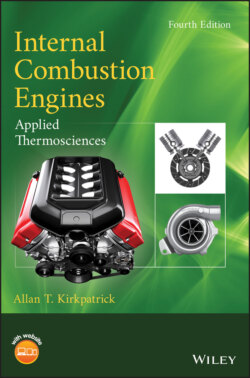Читать книгу Internal Combustion Engines - Allan T. Kirkpatrick - Страница 47
2.3 Constant Volume Energy Addition
ОглавлениеThis cycle is often referred to as the Otto cycle and considers the idealized case of an internal combustion engine whose combustion is so rapid that the piston does not move during the combustion process, and thus combustion is assumed to take place at constant volume. The Otto cycle is named after Nikolaus Otto (1832–1891) who developed a four‐stroke engine in 1876. Otto is considered the inventor of the modern internal combustion engine and founder of the internal combustion engine industry.
The Otto cycle engine is also called a spark‐ignition engine since a spark is needed to initiate the combustion process. As we shall see, the combustion in a spark‐ignition engine is not necessarily at constant volume. The working fluid in the Otto cycle is assumed to be an ideal gas. The Otto cycle example plotted in Figure 2.1 has a dimensionless energy addition = 20, a compression ratio = 8, and a specific heat ratio = 1.4.
The state processes for the Otto cycle are plotted in Figure 2.1. The four basic processes are:
| 1 to 2 | isentropic compression |
| 2 to 3 | constant‐volume energy addition |
| 3 to 4 | isentropic expansion |
| 4 to 1 | constant‐volume energy rejection |
Figure 2.1 The Otto cycle (, ).
The compression ratio of an engine is
(2.10)
The reader should be able to show that the following thermodynamic relations for the Otto cycle processes are valid:
Compression stroke
(2.11)
Constant volume energy addition
(2.12)
(2.13)
(2.14)
Expansion stroke
(2.15)
Energy rejection
(2.16)
where
The thermal efficiency nt is given by the usual definition:
(2.17)
where . If we introduce the previously cited relations for , Equation (2.12) and , Equation (2.16), we get
(2.18)
This cycle analysis indicates that the thermal efficiency of the Otto cycle depends only on the specific heat ratio and the compression ratio. Figure 2.2 plots the thermal efficiency versus compression ratio for a range of specific heat ratios from 1.2 to 1.4. Compression ratios found in actual spark‐ignition engines typically range from 6 to 11. The compression ratio is limited by two practical considerations: material strength and engine knock. The maximum pressure, , of the cycle scales with compression ratio as . Engine heads and blocks have a design maximum stress, which should not be exceeded, thus limiting the compression ratio. In addition, the maximum temperature also scales with the compression ratio as . If exceeds the autoignition temperature of the fuel–air mixture, combustion will occur ahead of the flame, a condition termed . The pressure waves that are produced are damaging to the engine, and they reduce the combustion efficiency. The knock phenomena is discussed further in Chapter 7.
The indicated mean effective pressure (imep) is
(2.19)
and if we nondimensionalize by the initial pressure , then
(2.20)
The nondimensional indicated mean effective pressure is plotted versus compression ratio and energy addition in Figure 2.2. As shown by Equation (2.20), the imep increases linearly with energy addition and to a lesser degree with compression ratio.
Figure 2.2 Otto cycle thermal efficiency and imep as a function of compression ratio and energy addition ().
